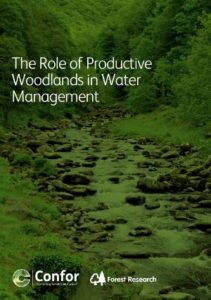New report highlights how productive tree planting can reduce flood risk
Planting productive woodland in specific areas of the UK could reduce the risk of flooding, according to a new report published by Confor. The Role of Productive Woodlands in Water Management contains a study by Forest Research and Confor highlighting the role productive woodland can play in lessening the likelihood of floods – as well as offering significant potential improvements to the water environment and a range of additional economic and environmental benefits.
The report notes that forests and woodland can reduce flooding in several ways:
- The greater water use of trees reduces flood volumes
- The higher infiltration rates of woodland soils reduces rapid surface run-off of water, reducing flood generation
- The ‘hydraulic roughness’ of trees, shrubs and large woody debris acts as a drag on flood waters, slowing flows
- Trees protect soil from erosion, decreasing the amount of sediment going into watercourses and reducing the need for dredging.
It also highlights how productive woodland can deliver specific benefits, including:
- Water use tends to be highest for productive conifer woodland
- Drier soils under productive woodland may make them better able to receive and store rainfall
- In general, larger areas of planting offer greater water benefits – and productive woodlands tend to be on a larger scale because they are more economical and attractive to landowners.
- Reducing pollutants in the water
Multiple additional benefits include driving investment and job creation in the forestry sector, reducing imports by securing domestic timber supplies and capturing carbon. The report says: “Society is increasingly threatened by flooding while the water environment remains seriously impacted by a range of human pressures. There is strong evidence to support woodland creation in appropriate locations to help manage these issues.”
It concludes: “There is a strong case for further investment in well-targeted woodland creation to help meet a wide range of environmental and social goals ” (including the Floods Directive, Water Framework Directive, Biodiversity 2020, greenhouse gas reduction, climate change adaptation and rural economic growth).
Opportunity Mapping
Forest Research has developed ‘opportunity mapping’ to identify, map and target areas where productive woodland could have the most positive impact.
Dr Tom Nisbet, of Forest Research, author of the report, said: “There is growing recognition that we need to develop a more sustainable approach to flood management involving a greater use of natural processes. Productive woodlands can be very good at reducing and slowing down flood flows, as well as helping to reduce the amount of soil and other pollutants entering our rivers.
“Since there are many demands on land, we have used opportunity mapping to target those areas where woodland creation can maximise water benefits and minimise risks. There is also scope to incorporate species suitability and potential productivity to show where planting productive woodlands can deliver the greatest environmental and economic benefits. This could include everything from small-scale farm schemes to strategic regional planting within large river catchments.”
Stuart Goodall, Chief Executive of Confor, said a change of mindset towards planting more productive woodland could make a major difference: “The previous English Woodland Grant Scheme introduced an enhanced grant rate in 2012 to encourage woodland planting to help reduce flood risk and improve water quality – but much of the 1800 hectares planted before the scheme closed in December 2013 was non-productive woodland, based on a misconception that more natural, less intensely-managed woodland can deliver more for the environment.
“This report shows that is not the case. Good management of modern productive woodlands can enhance water and other services, provide greater resilience to climate change, pests and diseases, while the timber provides income to secure long-term benefits to the environment. It is hoped the new Countryside Stewardship Scheme will recognise these benefits and place greater emphasis on planting productive woodland.”






